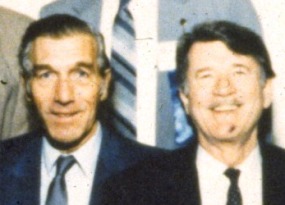 |
 |
 |
 |
 |
REFLECTIONS on the HISTORY
OF PSYCHOTHERAPY (Part 3)
Innovations in the 1960s - 1980s
Adam Blatner, M.D.
Part 1 : Overview through Freud,
Jung, Adler, Rank and Others Active Before 1940 Depth
Psychologists
Part 2: Pioneers in the late 1930s
through the End of the 50s
This is Part 3:
Innovations in the 1960s-80s: Humanistic Psychology, Family
Therapy, etc.
Part 4. Developments since the
1980s and Contemporary Trends.
Part 5. Further Reflections on the
History of Psychotherapy
Revised May 31, 2012
Proliferating Types
In the chart to the right you can see some of the types of therapy that proliferated in the 1950s through the 1990s. There are many branches off of the roots, From the left to the right you can see that behavior therapy gained some ground, and hypnotherapy had a bit of fashion in the 1970s-9s. Adlerian continued as a minor voice, and cognitive therapy and its offshoot, cognitive-behavior therapy flourished. The imagination therapists began to take on more power as positive psychology developed, and conjoint family therapy blossomed during that era, though it seems less prominent today. Psychoanalysis had shrunk but still evolving, and group therapy was making progress. M is for Moreno, psychodrama, sociodrama, family sculpture, a minor theme in itself but it influences many other approaches. Addictions groups and rehabilitation have been growing strong, and self-help seems to be a parallel effort. From the clump in the 70s of the EG, encounter group, more effort towards Gestalt therapy. Bioenergetic analysis and body therapies are in the mix, Jungian approaches continue, and allied to it, Transpersonal Psychotherapy weaves in spirituality, Finally, existential approaches on the right continue to have a voice. Many others, of course, but those are some highlightsHumanistic Psychology: A "Third Force"
Psychoanalysis has been called a "first" force in American psychotherapy, and Behaviorism, discussed in Part 2, arising from academic psychology, a second force. Behaviorism prided itself on being more "scientific." But a growing number of psychologists found both approaches excessively reductionistic. Psychoanalysis seemed overly concerned with the psychology of early childhood and how it continues into adulthood. Of course it does to varying degrees, but the point here is that adults can re-discover more mature coping approaches even without having recourse to psychotherapy. So humanistic psychology was an antithesis to this trend. Similarly, Behaviorism seems rooted in "rat psychology," a simplistic approach that, again, does have some applications with humans, but on the whole ignores the more complex abilities and higher motivations and enjoyments that humans have and animals hardly do---or not at all.Continuing the theme of dialectical processes, Humanistic Psychology arose as an antithesis to the perceived reductionism and materialism of both Psychoanalysis (The "First force") or Behaviorism (the "second force.") Humanistic Psychology as a "third force" addressed those psychological abilities that young children or animals cannot do, what is unique to humans---philosophize, create art in various modalities, work out problems symbolically, and in short, more consciously "sublimate," convert primitive feelings into more sublime and pro-social forms. (That's why it's "humanistic.") Thus, this approach represents a "third" force to balance the other two major fields within psychology.Some of the people to be discussed include the following: Carl Rogers, Abraham Maslow, Rollo May, Viktor Frankl, James F. T. Bugental, Charlotte Buhler, etc.
Existentialism allied with that peculiarity of American attitudes of self-improvement to create an alternative psychological approach, called "Humanistic Psychology." It was an antithesis to the reductionism of the other two dominant approaches in American Psychology at the time, and it had a good deal of appeal for a variety of reasons. It should be noted that the Second World War brought forth a rapidly increased demand for therapists, especially group therapists, for veterans, for families under stress, etc. The medical personnel, the psychiatrists, were far too few in number. Psychologists were primarily labaratory folks, but they were asked to do therapy, and having a taste of clinical work created a new field of endeavor: clinical psychology.
At first clinical psychology was largely psychoanalytic, but being denied training at many institutes (because they weren't physicians) decreased their allegiance and rendered them open to reasonable alternatives, alternatives which were already forming.
Carl R. Rogers, Ph.D.
One of the most important figures in the behavioral sciences was Carl Rogers, a product of the midwest who developed the most widely practiced approach in psychotherapy--widely practiced by mainly non-psychiatrists, by schoolcounselors, pastoral counselors, and many other disciplines which, as you remember from one of my early slides, far outnumber psychiatrists. Rogers
(1902-1987), active throughout the second 2/3 of his life,
developed what was variously known as non-directive,
client-centered, and person-centered therapy. He considered and
wrote about the basic conditions for effective therapy, apart
from the theories and techniques of the therapist. (This
anticipated what will be commented on in the next webpage on
integrations among the therapies. If the therapist expresses a
positive regard for the client, a fair degree of empathy, and
his behavior matches his ideology (i.e., "congruence"), then
clients improve. Rogers has been a major influence in the field
of counseling. Rogers offered a non-analytic approach which
nevertheless was non-directive, in the sense that it shunned
authoritarian advice-giving. Yet with time, therapists
transcended mere technique, valuing an authentic encounter more,
so Rogers later changed the name of his method to
"client-centered" therapy. Later, as he went beyond the clinical
setting into encounter groups, he again renamed it a
"person-centered" approach.
Rogers
(1902-1987), active throughout the second 2/3 of his life,
developed what was variously known as non-directive,
client-centered, and person-centered therapy. He considered and
wrote about the basic conditions for effective therapy, apart
from the theories and techniques of the therapist. (This
anticipated what will be commented on in the next webpage on
integrations among the therapies. If the therapist expresses a
positive regard for the client, a fair degree of empathy, and
his behavior matches his ideology (i.e., "congruence"), then
clients improve. Rogers has been a major influence in the field
of counseling. Rogers offered a non-analytic approach which
nevertheless was non-directive, in the sense that it shunned
authoritarian advice-giving. Yet with time, therapists
transcended mere technique, valuing an authentic encounter more,
so Rogers later changed the name of his method to
"client-centered" therapy. Later, as he went beyond the clinical
setting into encounter groups, he again renamed it a
"person-centered" approach.Abraham H. Maslow, Ph.D.
It was this expansion of clinical psychology beyond the
setting of treatment of "sickness" (however broadly you might
define it) to considering it a form of experiential education
which defined the "human potential movement", of which Abe
Maslow was considered a major pioneer. Maslow was a psychologist
trained in psychoanalysis ---most clinical psychologists
were---who was most active around 1950-70. He has been called
the "Grandfather of Humanistic Psychology" and has written
extensively about many things. He pointed out that healthy is
more than just the absence of sickness---a point I've spoken on
in a past series of lectures I called "flourishing." (In this
sense, Maslow is a precursor to a later wave in the evolution of
psychology called "positive psychology"---about which we'll talk
a bit in the 4th webpage, developments after 1990.) Maslow also
wrote about "self-actualization," the hierarchy of needs,
growth-oriented versus deficiency needs, and "peak
experience"---in this latter sense, anticipating the emergence
of transpersonal psychology (about which we'll speak later.) He
was persuasive and became the president of the American
Psychological Association.Maslow's vision of the possible human struck a chord in me, one which I continue to enjoy: Psychology can be re-framed as an important vehicle for personal growth, life-long education, indeed, a necessary component for adaptation to a rapidly changing world. Maslow's work---and indeed, the others too in this section---helped pave the way for the "human potential movement," to be discussed further on.
Viktor Frankl, M.D.
 Sometimes
considered an exponent of existential psychotherapy----the
fields blur into each other!----Dr. Viktor Frankl
was a psychiatrist who was also a survivor of the Nazi
concentration camps. In the 1950s he reflected on his experience
and concluded that there was a significant factor of attitude
operating. Some prisoners became selfish and antisocial and
depressed, others experiencing the same stresses chose to live
with faith and generosity! The quality of what happened to one
did not entirely determine how one reacted. Many people still
blame their mood and functioning on what happens "to" them, and
thoroughly deny that they have any freedom as to the attitude
they'll bring to life. Stress and cruelty automatically justify
constricted and resentful mind-attitudes, they apparently think.
Most don't think about it much, though.
Sometimes
considered an exponent of existential psychotherapy----the
fields blur into each other!----Dr. Viktor Frankl
was a psychiatrist who was also a survivor of the Nazi
concentration camps. In the 1950s he reflected on his experience
and concluded that there was a significant factor of attitude
operating. Some prisoners became selfish and antisocial and
depressed, others experiencing the same stresses chose to live
with faith and generosity! The quality of what happened to one
did not entirely determine how one reacted. Many people still
blame their mood and functioning on what happens "to" them, and
thoroughly deny that they have any freedom as to the attitude
they'll bring to life. Stress and cruelty automatically justify
constricted and resentful mind-attitudes, they apparently think.
Most don't think about it much, though. This links to existential psychiatry in many ways: Frankl is associated with that approach as much as with humanistic psychology. The boundaries are blurred and many don't care how they're classified. One theme here is to participate in more consciously creating meaning in a world without a commonly-shared mythos.Frankl recognized the importance of discovering meaning. Frankl was active from 1930 to 1980s and offered what he called "Logotherapy." He imagine that the need to find meaning was a basic motivation, and I agree that this is an instinctive drive, though not as primary as, say, thirst. Frankl emphasized the idea that we have choice regarding goals and values, and meaning can and must be discovered by each individual through creative action or experiencing. There is much to Frankl's work that deserved consideration, such as the technique of "paradoxical intention": When you purposely do what you are afraid to do, that reduces the out-of-control-ness of the experience.
Rollo May (photo to right, not above)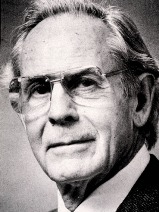
This pioneer in humanistic psychology and psychologist the
early 1950s began to address existential issues and popularize
them as elements to be integrated into psychotherapy here in
America. He was most active from arou 1950-1992, and focused on
a number of themes that draw on our higher abilities, such as
creativity, "the cry for myth," and the need in psychology for
an interdisciplinary approaches to human nature. Dr. May
emphasized the therapist's "presence" in sessions, and
also addressed the problems of dealing with death. Both May and
Frankl also began to take these ideas in another direction, that
of promoting more authentic encounters among individuals. The
late 1950s and early 1960s were a time of increased concern
about the dangers of being "phoney," of conforming mindlessly in
the corporate structure or in the fashions of clubs and schools.The Human Potential Movement
Flowering in the early 1960s through the later 1970s and continuing on today in many forms and locations, this trend grew out of the method of group work called the "T-Group," developed in the late 1940s by a team that included the psychologist Kurt Lewin and associates. These involved attempts to train community leaders to in turn direct equal opportunity programs. In these groups it became apparent that groups that could give direct feedback about how one "came across" to another---i.e., people could "encounter" each other more authentically. In a sense, these activities served as a non-pathologized form of group therapy---i.e., the people involved were not sick, but we all can do with an occasional "upgrading" of our behaviors and a bit of an "attitude adjustment.". Thus, the "T-group was born."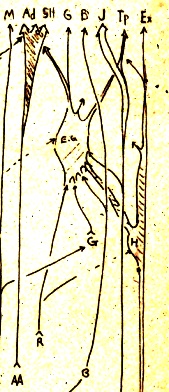
The Encounter Group: The T-group evolved in the 1950s into "sensitivity training groups" for helping teachers, businessmen, and other managers develop more effective interpersonal skills. Carl Rogers and others wrote about this kind of group being applied for all kinds of purposes, from interracial encounters to international meetings. It was a little influenced by Moreno, discussed in the previous webpage. This method included applications of role playing and the cultivation of empathy in business and education. In the 1960s this modality of constructive group work---what I call "action exploration"---was then fused with the ideals of humanistic psychology, and became the "encounter group." (See chart on the right, EG in the late 1960s to early 1970s. Many of the developments in this cultural flowering are noted in histories that have to do with one of the major centers for this work, Esalen Institute south of Monterey on the California coast. Other places were founded also in major urban centers in the United States and overseas. The encounter group was the natural vehicle for this merging of humanistic psychology and existential philosophy.
William Schutz, Ph.D.
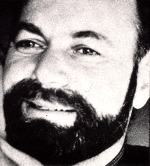 Will (as he was
known at the time) was a psychologist who moved from more
standard academic endeavors to integrating humanistic
psychology, the encounter group,. Active in this in the 1960s
through the early 1980s, he led action-oriented encounter groups
that integrated a variety of techniques taken from psychodrama,
Gestalt therapy, Bioenergetic Analysis (approaches to be
described in the next section below) as well as guided
imagery,sensory awakening, and sharing how they
felt with others about these experiences. I've found that if
around five of these warm-ups or activities are used, on average
one or two will be deeply moving, one or two will be somewhat
moving, and one will not touch the soul. So Schutz generally got
things stirred up, and from this people felt they had learned
more about themselves and others. Schutz held participants in
his groups responsible for themselves, for what
they got out of it, what they experienced. His two books were
"Joy" and "Here Comes Everybody"---written around 1970. The idea
of the encounter group became fashionable among the middle and
upper-middle classes, the "creative" class, and there were
hundreds of encounter groups held around the country and about
around the world, some in association with the aforementioned
"growth centers" like Esalen.
Will (as he was
known at the time) was a psychologist who moved from more
standard academic endeavors to integrating humanistic
psychology, the encounter group,. Active in this in the 1960s
through the early 1980s, he led action-oriented encounter groups
that integrated a variety of techniques taken from psychodrama,
Gestalt therapy, Bioenergetic Analysis (approaches to be
described in the next section below) as well as guided
imagery,sensory awakening, and sharing how they
felt with others about these experiences. I've found that if
around five of these warm-ups or activities are used, on average
one or two will be deeply moving, one or two will be somewhat
moving, and one will not touch the soul. So Schutz generally got
things stirred up, and from this people felt they had learned
more about themselves and others. Schutz held participants in
his groups responsible for themselves, for what
they got out of it, what they experienced. His two books were
"Joy" and "Here Comes Everybody"---written around 1970. The idea
of the encounter group became fashionable among the middle and
upper-middle classes, the "creative" class, and there were
hundreds of encounter groups held around the country and about
around the world, some in association with the aforementioned
"growth centers" like Esalen. One of the problems with a new fashion is that it tends to get quickly diluted and stereotyped, so that lesser trained group leaders became prevalent, strove for drama rather than integration, and as a result and a few--surprisingly few, in fact--casualties and some wary and negative propaganda, the encounter group as a general fashion petered out. However, it's been replaced by a host of theme-centered programs and workshops.
Gestalt Therapy and Fritz Perls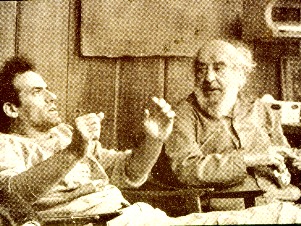
"Gestalt" is a German term for the mind's tendency to get
the whole picture at once. When they talk about grieving
relatives "seeking closure," that's a Gestalt idea. As a
therapy, it was developed in the late 1950s by Fritz and Laura
Perls, Paul Goodman and Ralph Hefferline. But when Frederick
Perls, M.D., (who insisted on being called "Fritz") moved to
Esalen Institute in the mid-1960s, he greatly popularized this
approach. Perls attended some of Moreno's
psychodrama workshops after immigrating to New York in 1947, and
his use of role reversal and the "empty chair" are effective
techniques which bring his theoretical approaches alive.
Alas, Fritz only only grudgingly acknowledged this: I heard him
say to Moreno at a conference in San Francisco in 1969, when
Moreno confronted him on this, "All right, Jake! Let it go!" (as
if his neglect of professional courtesy---and Fritz was famously
neglectful in many ways---was Moreno's problem). Anyway, Fritz
(seen here on the right of the picture on the right) integrated
Moreno's psychodramatic techniques such as the "empty chair,"
role reversal, and dream work, and in turn many Gestalt therapy
techniques were then integrated into Will Schutz' work and
others.Perls was a renegade psychoanalyst and more than a bit of a scamp, but also people found him to be remarkably perceptive and a bit charismatic. He died in 1970. His approach gave special attention to awareness in here-and-now, emphasized taking responsibility ("I won't" vs "I can't"), sought to separate feelings from intellectualizations, emphasized process over content, attended to body language, and also integrated other techniques. It has been applied in individual or group therapy. It should be noted that significant contributions to Gestalt therapy were made by Fritz'ex-wife Laura, along with Paul Goodman and other workers back in New York. Gestalt served as a dialectic antithesis from the past-orientation of analysis by emphasizing the present.
Transactional Analysis and Eric Berne, M.D.
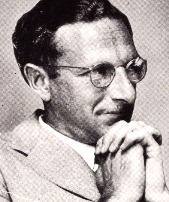 Berne another psychoanalyst
turned innovator, seeking in a dialectical process to simplify
the mystifying jargon of analysis and to tighten up the seeming
drifting nature of the process. He invited patients to set clear
goals, worked out contracts, and limited the focus. Active
between 1958 to 1970, when he also died (in no relation to the
circumstances of Perls), his method of Transactional Analysis
(abbreviated a "TA") was then popular. Berne had written a
best-selling non-fiction self-help book in the mid-1960s, Games
People Play. (Alas, Berne's use of the terms game and play
referred to the darker, more manipulative and one-upsmanship
usage of the terms, which reinforced a sense of wariness about
play---a topic that I'm sensitive about because I'm trying to
help people become more playful in a wholesome and kind way.)
Berne introduced a number of themes, such as goal-setting, and
the theme of education as part of therapy. I agree with
this---another example of the gradual accumulation of useful
contributions. You don't have to buy everything and abandon
everything else---you can take what you like---that's my
philosophy, and increasingly the philosophy of most therapists.)
Instead of id, ego, and superego, Berne proposed a less
jargon-like theory that everyone pops in and out of "ego states"
of the inner child, adult, and parent. Much of psychopathology
can be thought of as scripts, whole chains of games and types of
interactions.
Berne another psychoanalyst
turned innovator, seeking in a dialectical process to simplify
the mystifying jargon of analysis and to tighten up the seeming
drifting nature of the process. He invited patients to set clear
goals, worked out contracts, and limited the focus. Active
between 1958 to 1970, when he also died (in no relation to the
circumstances of Perls), his method of Transactional Analysis
(abbreviated a "TA") was then popular. Berne had written a
best-selling non-fiction self-help book in the mid-1960s, Games
People Play. (Alas, Berne's use of the terms game and play
referred to the darker, more manipulative and one-upsmanship
usage of the terms, which reinforced a sense of wariness about
play---a topic that I'm sensitive about because I'm trying to
help people become more playful in a wholesome and kind way.)
Berne introduced a number of themes, such as goal-setting, and
the theme of education as part of therapy. I agree with
this---another example of the gradual accumulation of useful
contributions. You don't have to buy everything and abandon
everything else---you can take what you like---that's my
philosophy, and increasingly the philosophy of most therapists.)
Instead of id, ego, and superego, Berne proposed a less
jargon-like theory that everyone pops in and out of "ego states"
of the inner child, adult, and parent. Much of psychopathology
can be thought of as scripts, whole chains of games and types of
interactions.An organization of transactional analysis grew up, and significant contributions were also made by Thomas Harris (who wrote another popular non-fiction book, "I'm ok, you're ok," and Claude Steiner. This popularization of psychology, like Harry Stack Sullivan's a generation earlier, emphasized the interpersonal field, and he taught about games, scripts, strokes, and other transactions which had a broad appeal for those clinicians seeking to strengthen the treatment alliance by educating patients regarding the nature of the psychology.
"Reality Therapy" and William Glasser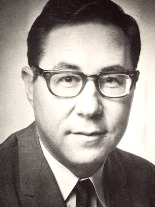
Another innovator around that time, and also in
California, was William Glasser, a psychiatrist whose work with
delinquent adolescents brought him to a more down-to-earth
approach he called "reality therapy." Active from 1956 through
the 1990s Glasser's work was especially used in working with
delinquents and in schools. He emphasized collaborative
assessment and planning, de-emphasizing "insight" as a goal,
writing about "schools without failure," the need for identity,
and above all, personal responsibility. Glasser focused on the
practical issues that required an enhanced approach to
responsibility---and I agree also with this dialectical
position. The idea that "you can't help it" offers a kind of
short-term relief and is perhaps better in small doses with
victims of trauma, but it's all-too-easy to over-do
victimization. The song "Dear Officer Krupke" in "West Side
Story" mocks this trend. Talking a supportive but not
co-dependent position, in the spirit of Alfred Adler (in my
opinion), Glasser went on to apply this approach more in the
schools----again like Adler---and for similar reasons--more of a
hope of a genuinely preventive approachRational-Emotive Therapy and Albert Ellis
Cognitive Therapy has become a mainstream approach---more about it in a moment----but it had a precursor: Beginning a generation earlier, Albert Ellis was a psychologist in New York who in the late 1950s developed what he called "Rational-Emotive Psychotherapy." The key point Ellis made back then and through to his death around 1985 is simply that much neurosis was based on faulty thinking, short cuts in reasoning. People need to recognize that RET (Rational-Emotive Therapy) involved a sequence of events in the mind: Events didn't just cause reactions, but rather there were intermediate steps: A, the activating even, collided with a B, belief! Aha! Driven in a weird reasoning pattern, mistaken beliefs led in its own inner logic to a C, consequent reaction, which for a lot of people was neurotic. Ellis added his own D---disputation. In a charming way---and southerners might find it abrasive, but folks in New York expected an argument---Ellis would dispute with his clients. That's how you work with folks who are used to argumentation. He'd joke with his patients, give them homework, and in other ways would trace out a more rational analysis of what their problems were about. His work in a sense set the stage for cognitive therapy. This of course was a rational, cognitive antithesis to the theses posed by psychoanalysis, because Ellis felt (and I agree) that classical psychoanalysis had insufficiently addressed, in an educational fashion, the fact that many patients have really quite childish modes of cognition.
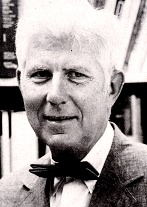 Cognitve Therapy and
Aron T. Beck, M.D.
Cognitve Therapy and
Aron T. Beck, M.D.
Yet another psychoanalyst, Aaron Beck, during the 1960s
was having a similar conflict with his training. Like Glasser,
Beck came to a conclusion that a certain amount of attention to
consciously reconstructing the attitude systems of especially
the mild to moderately neurotic patient was a particularly
important part of treatment. His pioneering was more successful
than the other approaches because his system could be presented
not as an art, but as a manual. It made it more accessible to
rigorous scientific testing, and by the late 1980s evidence was
accumulating that cognitive therapy was more effective than no
therapy, or vague non-directive therapy. Beck continued to be
active until recently. Because cognitive therapy accumulated so
much evidence, sometimes combined with a similarly scientific
behavior therapy (known then as cognitive behavior therapy or
CBT), this approach drew support from agencies who gave grants,
and from academic departments who want to support "science," and
from third party payers, insurance companies, who would not
reimburse for non-scientific non-evidence-based-therapies. Thus
does evolution select what is for that era, "the fittest."Cognitive therapy, like Ellis' approach but even more systematically, collaboratively analyzes the client's beliefs and habits of thought, offers new corrective exercises for the mind, suggests homework, practice, and rational dialogue. It's a more educational approach.
Frankly, I'm dubious that this is in itself fully adequate to cope with all forms of psychopathology, but most people with mild-moderate problems, and even many with more severe problems compound their troubles by thinking in ways that are grossly lacking in critical thinking. They easily over-generalize, and most have never even heard of the problems caused by over-generalization. Their parents and teachers and politicians do it all the time and never admit they're exaggerating. (I've told you this a million times! Ha ha.)
Psychopharmacology
A word here about a non-psychotherapy modality that has a whole history itself---the use of medications, sedatives, tranquilizers, SRIs and the like. They are over-used in many situations, and sometimes people are too afraid to use them when they really should give 'em a try. Often psychotherapy cannot progress well when the person is wracked by feelings that are way out of control. Some people with post-traumatic stress disorders and the like make good headway modifying their thinking when they're not just trying to cope with their emotional overloads. So a balance is sometimes useful. I note this because various forms of therapy work better when they're sensitively and appropriately combined with medication. More on this in the next webpage.Other Group Approaches
Some of these groups grew out of the Alcoholics Anonymous programs, others grew at the time from a confrontational anti-narcotic-abuse program called Synanon. They were also influenced by the encounter groups. Some began decades before the 1970s, but there was a flowering of various kinds of self-help groups during this era. Over the next few decades---and really, it's become mainstream, people helping others with similar programs has been promoted on national and local levels. Feminist consciousness-raising groups were part of this, as were families of addicts. The idea of "co-dependence" was brought into culture, as well as the corresponding idea of "enabling." It was recognized that sometimes family members subtly supported their spouse's or family member's addiction---or at least overlooked it. The difficulty of making an intervention was noted, and family violence was a related problem.Other groups devoted themselves to practical problems, like how to find a job or work in ordinary society. Part of the process of rehabilitation from stays in the hospital, these issues also had relevance for veterans returning from Vietnam, and more recently, the Middle East. Social skllls training, empathy training, assertion training and so forth was promoted for victims of abuse or trauma, while perpetrators of violence went to anger-management classes---sometimes on their own, sometimes mandated by the courts.
As the theme of addiction expanded beyond alcohol and hard drugs, self help groups, sometimes but not always based on AA's 12-step approach, also addressed smokers, people who engaged in compulsive sexuality (sometimes destroying their careers in the endeavor), over-eaters, gamblers, people who found themselves in debt, etc. More recently there are programs and groups for online-computer-game "addicts." ACOA ( "Adult Children of Alcoholics") programs added to the mix.
A point I'll make here is that psychotherapy and quasi-therapeutic support programs blur into healthy people seeking support for themselves and family members who have a wide range of problems. All this in my mind marks the gradual trend towards thinking psychologically, towards making some degree of introspection not only the province of psychotherapy, but of everyone. I think "psychological-ization" has moved the percentage of people who think about the way they think from a tiny fraction to only a small fraction that is growing greater each year.
Family Therapy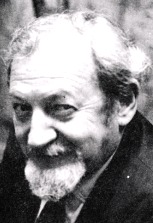
Let us turn to a very vital trend in psychotherapy---that
of seeing the whole family together as a unit. In the 1960s it
was more common for a psychiatrist to just see one person, and
another therapist would see the wife or child. It kept the
purity of the relationship, an important quality for more
traditionally psychoanalytic therapists. But in the spirit of
dialectic, the idea that this tradition outweighed the common
sense of working with people who lived together and interacted
seemed foolish. Common sense began to outweigh tradition,
orthodoxy. (If this seems a bit like religious issues, yes,
well, sad to say that in psychiatry around the mid-20th century
the different schools of psychotherapy were related to
unconsciously more as religions. In their defense, they really
didn't know how to get beyond these theories to think about
common denominators, but that started changing.)Some psychiatrists and clinical psychologists weren't caught up in these allegiances and were sufficiently independent-minded to try their own ideas. One of the first psychoanalysts who wrote around 1938 about working with the family was Nathan Ackerman, M.D., active between 1937 and 1968. Working in what he called "Psychodynamic Family Therapy, he realized that one couldn't act like an orthodox analyst in such a context. He intervened actively, talked about family roles, cut through denial, acknowledged his own reactions in a flexible way, and took a simple, casual approach. Others in the 1950s began to develop the nascent field of family therapy, including John Spiegel, John Bell, Theodore Lidz, Lyman Winne, etc.
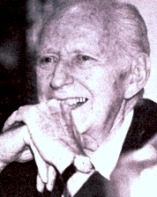 Murray
Bowen, M.D. (1913-1990)
Murray
Bowen, M.D. (1913-1990)
Murray Bowen in the 1950s took families of patients with
schizophrenia to live all together in a special hospital at NIMH
and began to formulate theories about enmeshment and boundaries.
The theme of recognizing and respecting boundaries between
people is important, but fifty years ago family members felt on
shame or hesitation at being psychologically intrusive. Pushing
food on unwilling children was just one example. Another theme
Bowen noted was that some family dynamics were carried from
grandparents to parents to children, and sometimes there were
influences from farther back. He would do family therapy with
several age groups!Bowen's "multi-generational family therapy" involved exploration of parents reacting to their own families of origin. These ideas have become incorporated in the more inclusive theory of how families work---it may seem obvious today, but in the early days adults were assumed (wrongly) to be fairly independent. Bowen used "genograms," little family tree maps, to explore with the family what was going on, how people felt about the cousin who killed himself, why was nothing said openly about the child who died, etc. People often hid things and felt no compunction to talk more openly about what turned out to be crucial issues.
Another dynamic Bowen explored was the way there were alliances, two people against one (a situation called "triangulation.". In the song, "Tea for Two," there was a line, "a boy for me, a girl for you." This was an era of continued gender identification, and all sorts of subtle distortions could be introduced. Words like "enmeshment" and "symbiosis" were introduced, trying to identify what made people crazy.
It turns out that there's little actual evidence that people with schizophrenia have crazier families than others, but it is true that most people do have a fair number of irrational patterns, stressful ones, and that stress worsens any mental condition, severe or mild. Relief of the stress won't cure the condition, we now know, but it might alleviate it a little. So family therapy is a good adjunct, an added element for any catastrophic illness. It's true whether there is a massive stroke, biological dementia, a traumatic burn, any major condition. Insight won't cure it, but anyone with major medical problems needs help in working out the stresses from and on families.
Ronald Laing, M.D.
Another figure sometimes associated with existentialism as well as with family therapy was Ronald Laing, a British psychiatrist whose early work seemed to suggest that in a way, some forms of mental illness were understandable as responses to a subtly insane family or social environment. Laing and a colleague, Aron Esterson, wrote about the family dynamics of some schizophrenic patients. He also helped start Kingsley Hall, a house in which patients were allowed to work through their madness without medicine. There were a few publicized successes which stimulated the founding of a number of such non-medical treatment homes in this country. The results apparently were sparse or short-lived enough so that this movement did not last. That it occurred around the end of the 1960s was no coincidence, and there was a spate of activities called "anti-psychiatry" which carried some of this populist tone occurring around that time.Salvadore Minuchin
Another family therapist active in the 1960s through the 1980s is Salvador Minuchin, who worked in the Philadelphia area, pioneering work with families of children with psychosomatic illness, anorexia,; and with poor, uneducated families. He called his approach "Structural Family Therapy" and it attended to problems of boundaries and patterns. He was active in his work, "re-framing"---stating a situation from a different viewpoint; modeling or demonstrating how someone might act in a more constructive way; and teaching families to wait, plan, reflect, internalize. What is important here is that he made therapy more educational, mixed with experience. Beginning in an era when directive therapy was not the norm---although it was in psychodrama---he led in modeling a more active style for other therapists.Carl Whitaker who did part of his training at the University of Louisville discovered that one needed to become more spontaneous and involved in order to work with the peculiarities of families. Around this time, the concepts of cybernetics, systems theory, ecology, and other ways of thinking about complex systems made it clear that one could not approach them in the old linear fashion of diagnosing a particular dynamic and addressing it--that was a mechanistic approach. A systems approach recognized that there were innumerable subtle and shifting variables which tended to maintain homeostasis--this was no mere matter of "resistance." The strategy shifted to promoting creativity and change, and allowing the family to work out the details of that change themselves.
The Mental Research Institute
Being a resident at Stanford in the mid-1960s, I was more influenced by these pioneers in family therapy. They had been influenced by Gregory Bateson, a communications theorist rather than a psychotherapist, but did pick up on the concept of mixed messages and the "double bind." This was also worked on by Don Jackson there in Palo Alto south of San Francisco. Here are some of the people who explored communications patterns, paradox, hypnosis, confusion, and other maneuvers, calling it "strategic family therapy." (At that time the initials MRI referred to these folks---they hadn't yet invented the magnetic resonance whatever---the neuro-diagnostic instrument. In California, a group of researchers near Stanford, at the Mental Research Institute (MRI--not the neurodiagnostic instrument), were exploring these issues from the point of view of communications---what they called "Strategic Family Therapy."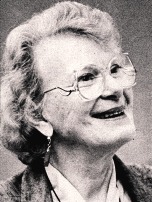 Virginia
Satir
Virginia
Satir
Virginia Satir has become especially well known because of
her popularized books and her positive way of working with her
clients. Like Rogers, she has expanded beyond the purely
clinical context and addressed the challenge of personal
development. Active: 1958-86, was a pioneer of Conjoint
Family Therapy. She also worked for a while at the Human
Potential Center called Esalen Institute a hundred miles south
on the California coast at Big Sur, and while there apparently
interacted with some psychodramatists. Her "people-making"
approach took on qualities of freely being an active
intermediary, and using various action techniques such
as "family sculpture" (see right,and slightly
below.). .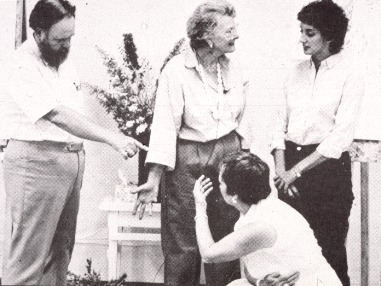
. Like Salvadore Minuchin, she wove education in with therapy, focused on clarity, explained family life chronology and was sympathetic with the goals of humanistic psychology To the right is a picture of her doing family sculpture.
"Body Work"
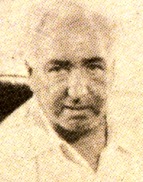 In every
movement, there are always some self-appointed fundamentalists,
claiming to have preserved the essence of the founder's idea,
perhaps even more purely than the founder believed. In the case
of Wilhelm Reich
(active 1925-1957) Picture to left: Reich took Freud's ideas
about sexuality and expanded on them. A mainstream psychoanalyst
in the 20s, Reich became aware of how up-tight many patients
were, how they held their body in rigid positions. He talked
about this "body armor" in a book in the 1930s titled "character
analysis," andwho became aware of the physical tightness of many
of his patients, what he called "character armoring." He
called his approach Character-Analytic Vegetotherapy and
believed that sexuality and a full, unrestrained orgasm were key
dynamics for the optimal flow of the life force, libido. He'd
have patients physically activate energy through kicking,
beating pillows, biting towels. This brought up free
associations, memories "stored" in the blocked muscles. He ended
up getting into trouble with the FBI for claiming that he could
capture and store and use "orgone," an invisible substance in
the cosmos.
In every
movement, there are always some self-appointed fundamentalists,
claiming to have preserved the essence of the founder's idea,
perhaps even more purely than the founder believed. In the case
of Wilhelm Reich
(active 1925-1957) Picture to left: Reich took Freud's ideas
about sexuality and expanded on them. A mainstream psychoanalyst
in the 20s, Reich became aware of how up-tight many patients
were, how they held their body in rigid positions. He talked
about this "body armor" in a book in the 1930s titled "character
analysis," andwho became aware of the physical tightness of many
of his patients, what he called "character armoring." He
called his approach Character-Analytic Vegetotherapy and
believed that sexuality and a full, unrestrained orgasm were key
dynamics for the optimal flow of the life force, libido. He'd
have patients physically activate energy through kicking,
beating pillows, biting towels. This brought up free
associations, memories "stored" in the blocked muscles. He ended
up getting into trouble with the FBI for claiming that he could
capture and store and use "orgone," an invisible substance in
the cosmos.While this speculation hasn't been adequately proven, his earlier work was important. Further work has shown that muscular tension patterns were psychosomatic modes of defense rather than a purely intrapsychic mode, and it needed to be addressed in many cases if progress were to be made. He wrote a book about character analysis in the early 30s that remained well respected.
However, Reich believed in Freud's early ideas about libido, indeed about the need for sexual release, in orgasm, for health. He came to think that there was some kind of subtle force which could actually be utilized, tapped into--he called it "orgone", and through this he drifted into the fringes--or perhaps, some would say, off the edge.
Alexander Lowen, M.D.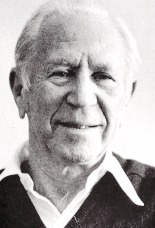
One of Reich's students, Lowen also went on to become a
psychiatrist and sought to refine the best of his mentor's
ideas. Active around 1956-86, Lowen's work was called
"Bioenergetic Analysis," and involved working with the patient's
body in positions likely to evoke emotional reactions, catharsis
and insight. He helped people to feel their body experience
"energetic streaming." Diagnosis of various complexes would be
made depending on the patient's posture, how he carried his
bodies. Traumatic and confused "memories" were "held" or
expressed in defensive tightening of whole muscle groups. For
example, people who have become afraid of their sexuality would
tend to hold their genital area pulled slightly back, as
reflected by a pushed out buttocks and increased curvature in
their lower back. Bioenergetic analysis is perhaps the most
vibrant approach in therapy, and deserves to be explored
regarding which elements can be most effectively integrated in
which situations.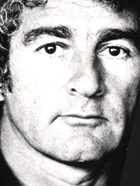 Arthur Janov's
"primal therapy" became fashionable for a while, perhaps because
it seemed so extreme, integrating elements of bioenergetics and
psychodrama in his own synthesis of intensive, regressive
approaches. Active: 1968-79, his book, The Primal Scream was
fashionable in self-help sub-cultures. He sought to promote
catharsis through regression, through bioenergetic-like
exercises, He held intensive workshops, but his work offered
little intellectual integration. Janov would have his clients
enact scenes as if they were children, crying out for Mommy to
stay home, repeatedly crying--an activity which does tend to
bring forth memories and feelings related to that time in life
when one was vulnerable in that infantile sense. It hasn't
caught on, I think, because, aside from it being too dramatic
for most people, Janov failed to build in an adequate program
for integrating the insights, for what analysts loosely call
"working through."
Arthur Janov's
"primal therapy" became fashionable for a while, perhaps because
it seemed so extreme, integrating elements of bioenergetics and
psychodrama in his own synthesis of intensive, regressive
approaches. Active: 1968-79, his book, The Primal Scream was
fashionable in self-help sub-cultures. He sought to promote
catharsis through regression, through bioenergetic-like
exercises, He held intensive workshops, but his work offered
little intellectual integration. Janov would have his clients
enact scenes as if they were children, crying out for Mommy to
stay home, repeatedly crying--an activity which does tend to
bring forth memories and feelings related to that time in life
when one was vulnerable in that infantile sense. It hasn't
caught on, I think, because, aside from it being too dramatic
for most people, Janov failed to build in an adequate program
for integrating the insights, for what analysts loosely call
"working through."Other people who did "body work" further promoted antitheses to Freud's primarily intellectual form of "talk therapy." Included in this endeavor would be some of the following:
- Moshe Feldenkrais' "Awareness Through Movement" ; - Frederick M. Alexander ("the Alexander Method") ; Ida Rolf's "Structural Reintegration" ; - Albert Pesso's "Psychomotor Therapy" And of course, elements of body work is also used in Gestalt therapy, psychodrama, primal therapy, dance therapy, etc.These and other forms of "body work" also have extensive histories of their owns, claims, dramatic cures,a and so forth. They all share in seeking to dissolve the false mind/body dichotomy that has been a hindering part of our intellectual culture since the work of Descartes in the Seventeenth Century.
The Creative Arts and Expressive Therapies
Early on, asylum superintendents noticed that some of their inmates were healthy enough to engage in creative arts projects such as painting, writing poetry, or putting on plays. In the 1960s professionals in art therapy, music therapy, poetry therapy, drama therapy, dance and movement therapy all moved towards forming their own professional organizations. Some were more influenced by psychoanalysis, or Jung's analytical psychology; others were more influenced by the creativity emphasis and improvisational dynamics in the psychodrama theories of J.L. Moreno.Another group called itself "expressive therapy" and they believed that combining several types---dance and art, poetry, music, and drama, any combination, often worked synergistically to promote more self-awareness.
I'm mentioning Moreno again because in a way psychodrama functions as a synthesis between the regressive, cathartic experiential mode of action insight in Bioenergetic Analysis and the cognitive thoughts that are expressed in the words that are spoken in the dramatic encounter. Moreno's work also synthesizes existential themes--indeed, he coined the term encounter in 1914--and humanistic in his integration of play, spontaneity and creativity. I've found my work with psychodrama also leads me to promote and integrate the other creative arts therapies which I think need to be taken more into the mainstream. I envision day treatment and inpatient programs, outpatient group programs, all utilizing action techniques and drama, music, singing, dancing, creative movement, poetry, bibliotherapy, and various art experiences in order to promote group cohesion, self-expression, and self-esteem.
Roberto Assagioli, M.D.: Psycho-Synthesis
Instead of just analyzing, taking things apart and hoping insight will do the work (i.e., Freud), how about directly fostering a greater degree of integration in the personality? Of course, what Assagioli wanted to do beginning in the 1920s was to integrate a more holistic and almost Buddhist approach---dis-identifying the sense of self from the administrative ego functions, developing various ego functions such as the powers of will or imagination, and the like.Psychosynthesis became more known in the USA in the 1960s and 70s.Indeed, synthesis or integration is in itself therapeutic. More recently, Dr. Daniel Siegel has written a book titled "Mind-Sight" that carries a similar message.
In the spirit of working towards more integration, a word about one of the early synthesizers: Roberto Assagioli as a young psychiatrist in the 1920s recognized that psychoanalysis had a great deal to offer, but like Jung, felt that more was needed. In the spirit of dialectic, he called his approach, instead of psycho-analysis, "psycho-synthesis."
Assagioli added a variety of techniques: he was an early eclectic. Guided imagery, homework, inner dialogue, and the like were useful elements which have facilitated the emergence of interest in other new therapies which use imagery. In addition, he emphasized the need to integrate a "higher self" dimension, anticipating the Twelve Step tradition. Later on, he agreed with Rank in aiming not only at cognitive development, but also at a focused practice of "will training."
The Imagery Therapies
Getting patients to imagine scenes could be diagnostic and therapeutic. It relates a bit to Jung's use of active imagination, but also arises from the creative work of a number of other innovators:Joseph Shoor developed Psycho-imagination therapy ; HansCarl Leuner invented the technique of guided affective imagery ; Akhter Ahsen and Anees Sheikh wrote books about "Imagery in Therapy." Imagery was also an important component in relaxation, for biofeedback, for healing, stress reduction, and the like. Generating images was part of the therapeutic approaches of psychodrama, Gestalt therapy, psychosynthesis, the arts therapies, and so forth. biofeedback/ voluntary controls
Hypnotherapy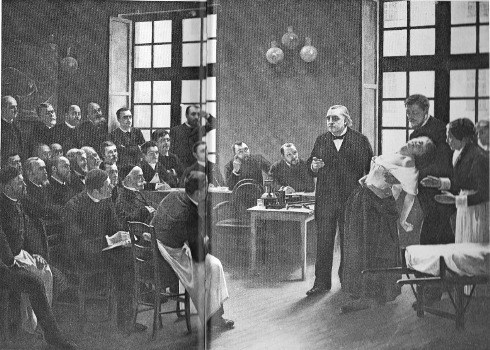
One of the oldest approaches to psychotherapy, it involves
the power of suggestion. This of course could be a whole lecture
or series. Some key people that you could google if you want to
learn more include the remarkable career of Anton Mesmer, @1795,
whose "animal magnetism" is generally considered to be a popular
usage of this method. Braid first used the word "hypnosis" to
describe the process. Moving forward, the famous Charcot, @1880,
at the Salpietre in France, found that hypnotic suggestion was
especially influential in the diagnosis and treatment of the
mysterious condition known as "hysteria." Charcot was an
important influence on Freud, who visited him over a period of
some months. Other names in France include Liebault,
Bernheim---this person noting the power of "suggestion."
Suggestion was a fairly widespread treatment approach around the
1890s and was tried and abandoned as a method by Freud. Hypnosis
then feel into into disuse except as a form of
entertainment in shows. Hypnosis was revived again for the
treatment of War Neurosis in mid-1940s, and there's been a
gradual revival since then in many fields, such as dentistry,
psychosomatic medicine, and the like. Research on hypnosis has
been done buy people such as H. Spiegel, Gill & Brennan,
Lewis Wolberg, M. Orne, Ernest Hilgard, T. Barber etc.Milton Erickson, M.D.
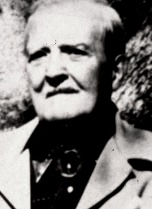 This
fascinating man, paralyzed in his legs, was a psychiatrist who
has been an especially important figure in bringing hypnosis
back into psychotherapy. Remember, it was his foundation in
Phoenix that sponsored the Evolution of Psychotherapy conference
I mentioned at the outset. Most active in the period around
1960-80, others such as Jay Haley have studied and written about
what it was Erickson did: "Strategic Hypnotherapy" often used
indirect suggestions, metaphors, anchoring, pacing, and, in
short, exploring the manipulation of the subtleties of
interpersonal communication.
This
fascinating man, paralyzed in his legs, was a psychiatrist who
has been an especially important figure in bringing hypnosis
back into psychotherapy. Remember, it was his foundation in
Phoenix that sponsored the Evolution of Psychotherapy conference
I mentioned at the outset. Most active in the period around
1960-80, others such as Jay Haley have studied and written about
what it was Erickson did: "Strategic Hypnotherapy" often used
indirect suggestions, metaphors, anchoring, pacing, and, in
short, exploring the manipulation of the subtleties of
interpersonal communication. Erickson's work has been influential on the communications work in family therapy, in the development of an offshoot you may have heard about called "neurolinguistic programming" or NLP, and for the generation of a variety of important techniques which have a great deal of promise in everyday therapy. I think we haven't begun to tap into the power of hypnosis and dare to speculate that our great-grandchildren may be taught how to do this as part of schooling just as our kids are taught that of course you will learn to read and write---that's just what civilized people do.
Multimodal Therapy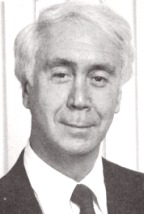
Arnold Lazarus, Ph.D.
was a behavior therapist who realized that different patients
needed all sorts of approaches, cognitive, imagery, behavior,
the lot: Active in the 1960s through the 1990s, Dr. Lazarus'
utilized an eclectic approach to diagnosis and created specific
treatments that fit each individual patient's BASIC ID--- an
acronym for taking into account:B ehaviors ; A ffective experiences ; S ensory experiences ; I magery ; C ognitions ; I nterpersonal dynamics ; D rugs for psycho-physical adjustment
The advantage of Lazarus' approach is its systematic application. It also anticipates the current and increasing trend towards eclecticism.
Part 4: More Recent Trends
In the next section (part 4) I'll discuss other developments and more recent trends and reflect on the field.- - -Recent Reference:
. Email to adam@blatner.com
Return to top.
